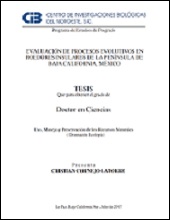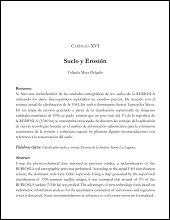Evaluación de procesos evolutivos en roedores insulares de la Península de Baja California, México
Resumen
"Los taxa de Haplomylomys (Rodentia: Cricetidae) son un subgénero de Peromyscus. Se distribuyen ampliamente en el suroeste de Estados Unidos de América y el noroeste de México, incluyendo varias islas circundantes a la península de Baja California (PBC). La taxonomía de Haplomylomys ha sido estudiada desde principios del siglo XX, cuando se propusieron las primeras clasificaciones con base en caracteres morfológicos. Sin embargo, las relaciones genealógicas entre las especies y subespecies de Haplomylomys aún no han sido completamente entendidas debido a la presencia de taxa crípticos. Los objetivos de este trabajo fueron evaluar la historia evolutiva del subgénero Haplomylomys y dilucidar los principales eventos geológicos y climáticos que han estructurado la filogenia del grupo. Se consideró que debido a que el proceso de aislamiento de los roedores de la PBC está asociado al Último Máximo Glacial (ÚMG), se espera que las formas insulares de Haplomylomys no difieran genéticamente con respecto a los taxa de tierra firme y que sean subespecies de éstas. Para evaluar este supuesto, se amplificaron y secuenciaron tres genes mitocondriales (Cytb [800 pares de bases (pb)], COI [658 pb] y COIII [700 pb]). El tamaño de muestra fue de 61 individuos, considerando tanto poblaciones de tierra firme como insulares, los cuales pertenecen a 11 taxa reconocidos actualmente como especies. Como grupo externo se incluyeron a las siguientes especies: Peromyscus maniculatus, P. sejugis, P. boylii y P. leucopus. Para determinar las distancias genéticas entre los taxa se emplearon los modelos de evolución molecular Kimura 2-parametros y Jukes-Cantor. Además se determinó el modelo evolutivo correspondiente para cada gen mitocondrial con la finalidad de realizar análisis filogenéticos individuales y un análisis particionado con todas las secuencias concatenadas (2,158 pb). Se obtuvieron dos modelos de evolución molecular; para Cytb se empleó el modelo GTR+I+G, y para COI y COIII el modelo TIM2+I+G. Todos los métodos de inferencia filogenética (Neighbor-Joining, Máxima Verosimilitud, Inferencia Bayesiana y estimación bayesiana de los tiempos de divergencia [datación molecular]) fueron consistentes en la identificación de cuatro clados monofiléticos recíprocos con un fuerte soporte de bootstrap (> 90%) dentro del grupo eremicus..." "The taxa of Haplomylomys (Rodentia: Cricetidae) are a subgenus of Peromyscus. It’s are widely distributed in northwestern Mexico and the southwestern United States, including several islands surrounding the Baja California peninsula (BCP). The taxonomy of Haplomylomys has been studied since the beginning of the 20th century, when the first classifications were proposed based on morphological characters. However, the genealogical relationships between islands taxa within the eremicus group remain poorly understood due to the presence of cryptic taxa. In this work, the goals were to assess the evolutionary history of Haplomylomys and identify the main geological and climatic events that might have affects its phylogeny. I tested the hypothesis that the island taxa of the subgenus Haplomylomys show limited genetic differences with respect to mainland taxa because its recent isolation process has been associated with the Last Glacial Maximum (LGM). Phylogenetic relationships were analyzed using three mitochondrial gene fragments (Cytb [800 base pairs (bp)], COI [658 bp], and COIII [700 bp]) from 61 individuals, considering both mainland and island populations belong to 11 taxa currently recognized as species, collected through the geographic range of Haplomylomys. As outgroup group the following species were included: Peromyscus maniculatus, P. sejugis, P. boylii, and P. leucopus. Genetic distances were calculated using the Jukes-Cantor and Kimura 2-parameter models of molecular evolution. To determine the best model of evolution of each gene mitochondrial and concatenated data set (2,158 bp), the Akaike information criterion was used. The parameters obtained from two evolutionary models for the phylogenetic approaches were used. For Cytb the model GTR+I+G was used, while for COI and COIII was the model TIM2+I+G. Phylogenetic inferences (Neighbor-Joining, Maximum likelihood, Bayesian inference, and molecular dating) identified two main clades. The first includes P. californicus; the second, all the species within the eremicus group divided into four clades with strong bootstrap support (> 90%). Phylogenetic analyzes, molecular dating, and the values obtained from measures of genetic distances suggest taxonomic changes at species and subspecies level in three clades identified for island taxa of the eremicus group..."
Colecciones
Ítems relacionados
Mostrando ítems relacionados por Título, autor o materia.
-
PROMOCIÓN DEL PERIFITON PARA EL CULTIVO DE CAMARÓN BLANCO: HACIA UNA ACUICULTURA ECOLÓGICA
DOMENICO VOLTOLINA LOBINA; JUAN MANUEL AUDELO NARANJO; MARIA DEL ROSARIO PACHECO MARGES -
Suelo y Erosión
YOLANDA LOURDES MAYA DELGADO


